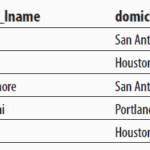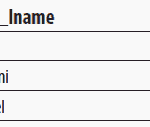The Transact-SQL language has one basic statement for retrieving information from a database: the SELECT statement. With this statement, it is possible to query information from one or more tables of a database (or even from multiple databases). The … [Read more...] about SQL SELECT – Its Clauses and Functions
Queries
WHERE Clause – SELECT Statement
Often, it is necessary to define one or more conditions that limit the selected rows. The WHERE clause specifies a Boolean expression (an expression that returns a value of TRUE or FALSE) that is tested for each row to be returned (potentially). If … [Read more...] about WHERE Clause – SELECT Statement
Boolean operators AND, OR & NOT – WHERE Clause
WHERE clause conditions can either be simple or contain multiple conditions. Multiple conditions can be built using the Boolean operators AND, OR, and NOT. The behavior of these operators was described in section "NULL Values" using truth … [Read more...] about Boolean operators AND, OR & NOT – WHERE Clause
IN and BETWEEN Operators – WHERE Clause
An IN operator allows the specification of two or more expressions to be used for a query search. The result of the condition returns TRUE if the value of the corresponding column equals one of the expressions specified by the IN … [Read more...] about IN and BETWEEN Operators – WHERE Clause
NULL Values, LIKE Operator in WHERE Clause
A NULL in the CREATE TABLE statement specifies that a special value called NULL (which usually represents unknown or not applicable values) is allowed in the column. These values differ from all other values in a database. The WHERE clause of a … [Read more...] about NULL Values, LIKE Operator in WHERE Clause
GROUP BY and HAVING Clauses – SELECT Statement
The GROUP BY clause defines one or more columns as a group such that all rows within any group have the same values for those columns. Example 6.22 shows the simple use of the GROUP BY clause in a SELECT statement.Example 6.22Get all jobs of … [Read more...] about GROUP BY and HAVING Clauses – SELECT Statement
Aggregate Functions in SELECT Statement
Aggregate functions are functions that are used to get summary values. All aggregate functions can be divided into several groups:Convenient aggregate functionsStatistical aggregate functionsUser-defined aggregate functionsAnalytic aggregate … [Read more...] about Aggregate Functions in SELECT Statement
ORDER BY Clause – SQL Server
The ORDER BY clause defines the particular order of the rows in the result of a query. This clause has the following syntax:The col_name column defines the order. col_number is an alternative specification that identifies the column by its … [Read more...] about ORDER BY Clause – SQL Server
SELECT Statement and IDENTITY Property
The IDENTITY property allows you to specify a counter of values for a specific column of a table. Columns with numeric data types, such as TINYINT, SMALLINT, INT, and BIGINT, can have this property. The Database Engine generates values for such … [Read more...] about SELECT Statement and IDENTITY Property
CREATE SEQUENCE Statement
Using the IDENTITY property has several significant disadvantages, the most important of which are the following:You can use it only with the specified table.You cannot obtain the new value before using it.You can specify the IDENTITY property … [Read more...] about CREATE SEQUENCE Statement
Set Operators (UNION, INTERSECT and EXCEPT)
In addition to the operators described earlier in the chapter, three set operators are supported in the Transact-SQL language:UNIONINTERSECTEXCEPTUNION Set OperatorThe result of the union of two sets is the set of all elements appearing … [Read more...] about Set Operators (UNION, INTERSECT and EXCEPT)
CASE Expressions in SELECT Statements
In database application programming, it is sometimes necessary to modify the representation of data. For instance, a person’s gender can be coded using the values 1, 2, and 3 (for female, male, and child, respectively). Such a programming technique … [Read more...] about CASE Expressions in SELECT Statements
Subqueries (Comparison, IN, ANY and ALL Operators)
All previous examples in this chapter contain comparisons of column values with an expression, constant, or set of constants. Additionally, the Transact-SQL language offers the ability to compare column values with the result of another SELECT … [Read more...] about Subqueries (Comparison, IN, ANY and ALL Operators)
Temporary Tables in SQL Server
IntroductionWhat Are Temporary Tables?In SQL Server, temporary tables serve as a means for storing data temporarily, so you can manipulate and transform the data before arriving at the final result. Unlike permanent tables, which persist as a … [Read more...] about Temporary Tables in SQL Server
SQL JOIN – JOIN Operator (Explicit join, Implicit join)
The previous sections of this chapter demonstrated the use of the SELECT statement to query rows from one table of a database. If the Transact-SQL language supported only such simple SELECT statements, the attachment of two or more tables to retrieve … [Read more...] about SQL JOIN – JOIN Operator (Explicit join, Implicit join)
Natural Join – Cartesian Product
The phrases “natural join” and “equi-join” are often used as synonyms, but there is a slight difference between them. The equi-join operation always has one or more pairs of columns that have identical values in every row. The operation that … [Read more...] about Natural Join – Cartesian Product
Outer Join – JOIN Operator
In the previous examples of natural join, the result set included only rows from one table that have corresponding rows in the other table. Sometimes it is necessary to retrieve, in addition to the matching rows, the unmatched rows from one or both … [Read more...] about Outer Join – JOIN Operator
Theta join, Self-join, Semi-join
The preceding sections discussed the most important join forms. This section shows you three other forms:Theta joinSelf-joinSemi-joinThe following subsections describe these forms.Theta JoinJoin columns need not be compared using the … [Read more...] about Theta join, Self-join, Semi-join
Correlated Subqueries
A subquery is said to be a correlated subquery if the inner query depends on the outer query for any of its values. Example 6.70 shows a correlated subquery.Example 6.70Get the last names of all employees who work on project … [Read more...] about Correlated Subqueries
Subqueries and the EXISTS Function
The EXISTS function takes an inner query as an argument and returns TRUE if the inner query returns one or more rows, and returns FALSE if it returns zero rows. This function will be explained using examples, starting with Example 6.71.Example … [Read more...] about Subqueries and the EXISTS Function



